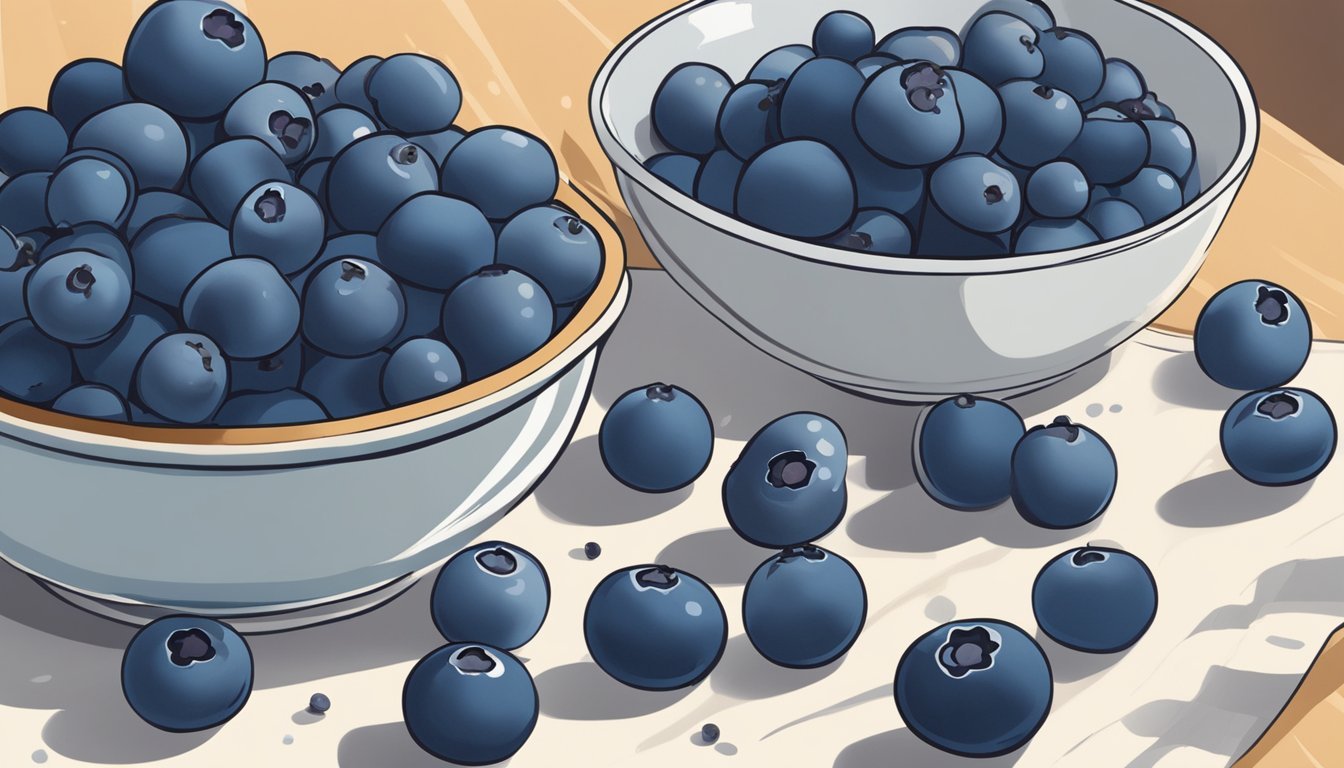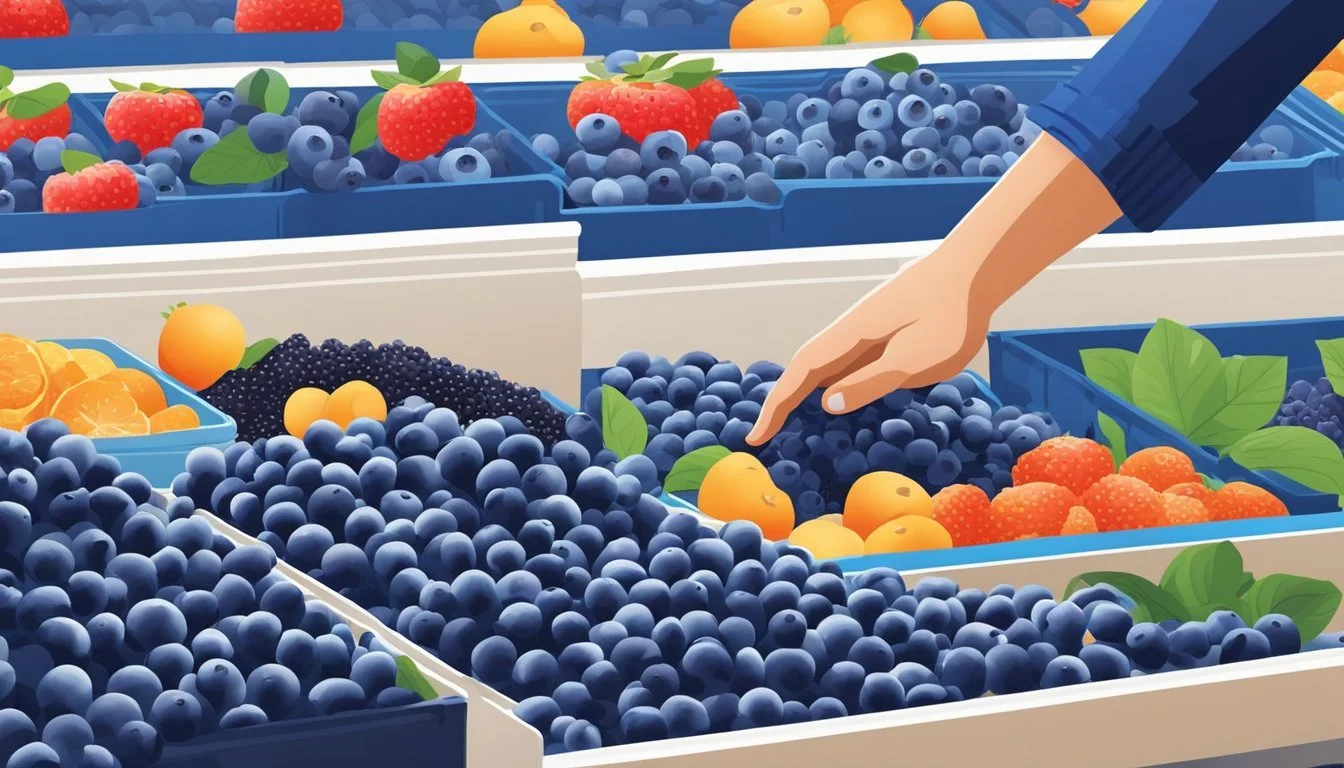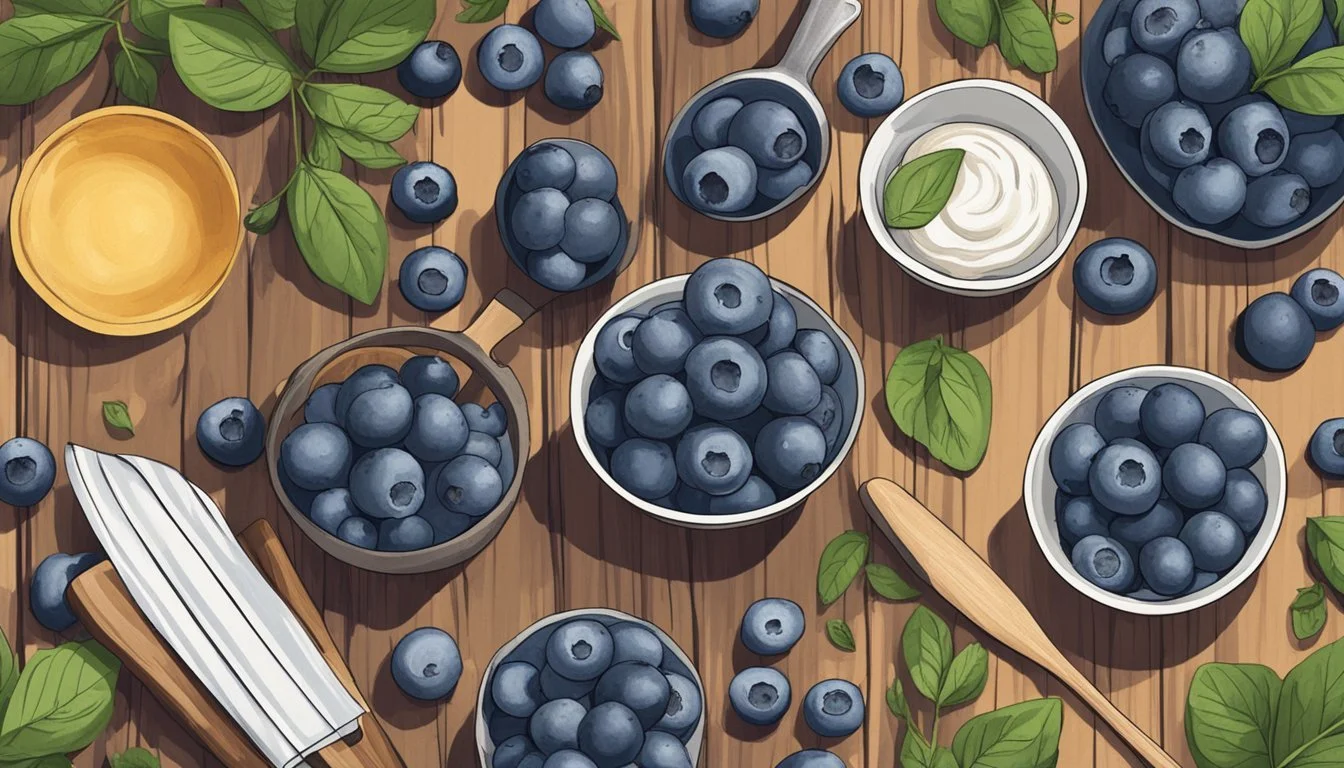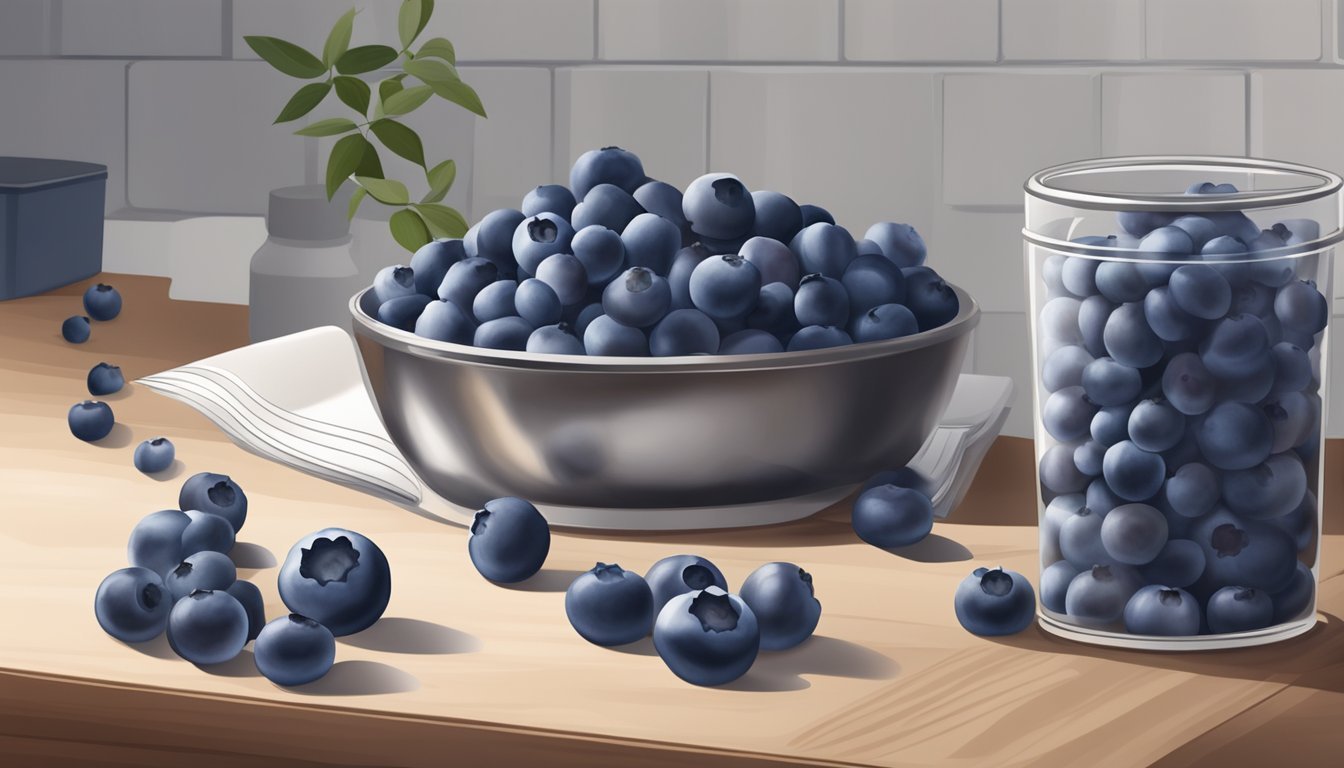How Long Do Blueberries Last?
Shelf Life and Storage Tips
Blueberries, a popular superfood, are renowned for their versatility and health benefits. They are often purchased in bulk when in season or on sale. However, despite their hardy appearance, blueberries have varying lifespans depending on how they are stored. Under optimal conditions, fresh blueberries can last anywhere from a few days to a couple of weeks.
When stored properly in the refrigerator, blueberries can last up to two weeks. It's preferable to consume them within one week for the best taste and texture. If one plans to extend their shelf life, freezing is an effective option. Frozen blueberries can maintain their quality for about 6 to 8 months. Proper freezing involves spreading the blueberries on a baking sheet to prevent them from sticking together and transferring them to a freezer bag once frozen.
Understanding the shelf life and storage methods is crucial for minimizing waste and ensuring the blueberries remain as fresh as possible when consumed. These tiny fruits do not typically come with a use by date or best before date, so using them in a timely fashion after purchase is advisable for peak quality.
Understanding Blueberries
Blueberries are small, nutrient-dense fruits with a signature deep blue color, often heralded for their health benefits and culinary versatility. They are a rich source of antioxidants and associated with promoting heart health and potentially reducing cancer risk.
Nutritional Value
Blueberries pack a significant nutritional punch in a small package. They are particularly renowned for their high levels of antioxidants, especially anthocyanins, which give them their blue color and contribute to health benefits. These antioxidants may help in neutralizing harmful free radicals, potentially reducing the risk of chronic diseases such as cancer and improving heart health.
Here's a brief overview of the nutritional profile per 1 cup (148 grams) of fresh blueberries:
Calories: 84
Dietary Fiber: 3.6g
Vitamin C: 14.4mg
Vitamin K: 28.6mcg
Manganese: 0.5mg
Blueberries are also a good source of several other vitamins and minerals, contributing to their reputation as a beneficial addition to a healthy diet.
Varieties and Seasonality
There are two primary categories of blueberries commonly found in the market: highbush and lowbush. Highbush blueberries are the larger variety typically available fresh in grocery stores, whereas lowbush blueberries are smaller, often found in the wild and are more commonly sold frozen or used in processed foods.
Blueberries thrive in climates with cold winters and moderate summers, which is why they are often harvested between April and September in the Northern Hemisphere, depending on the latitude. The availability and peak season can vary by variety and region, making them more accessible globally throughout different times of the year. However, with the advent of global trade and agricultural advancements, blueberries can frequently be found year-round.
Determining Blueberry Freshness
When evaluating the freshness of blueberries, one should look for certain visual and textural cues that indicate quality. Two key aspects to focus on are the color and texture of the berries as well as noticeable signs that the berries are aging or have damage.
Color and Texture Indicators
The ideal blueberry exhibits a blue-black color, which is a strong indicator of ripeness and freshness. They should be firm to the touch and plump with a natural bloom — a silvery-white sheen as part of their natural protection. Their skin must be smooth without wrinkles, which can signify dehydration or age.
Ripe and fresh indicators:
Color: Blue-black
Feel: Firm and plump
Surface: Smooth with a natural silvery bloom
Signs of Aging or Damage
As blueberries age or if they're damaged, one may notice that the berries become mushy or wrinkled, which suggests they are past their prime. If the blueberries start to emit a sour smell or taste, that can also signal that they are no longer fresh. It's crucial to inspect the berries for any signs of mold, which can spread quickly and spoil a batch.
Aged or damaged warnings:
Texture: Mushy or wrinkled skin
Odor: Sour-smelling
Visual: Presence of moldy spots
Storing Blueberries at Home
When storing blueberries at home, maintaining freshness hinges on proper refrigeration or freezing. It's crucial to ensure that blueberries remain dry and are stored in an appropriate container to extend their shelf life.
Ideal Conditions for Refrigeration
To store blueberries in the refrigerator, they should first be kept dry because any moisture can accelerate mold growth. Here are specific steps for refrigeration:
Start by placing the blueberries in a breathable container, such as the plastic clamshell they often come in, or transfer them to a bowl covered loosely with plastic wrap to allow for air circulation.
Line the container with paper towels to absorb any excess moisture.
Store the blueberries in a single layer to prevent them from crushing each other, which can lead to quicker spoilage.
Do not wash the blueberries until right before consumption to reduce the risk of mold and excess moisture.
The ideal refrigerator temperature for storing blueberries is 34°F to 38°F (1°C to 3°C), with a controlled humidity setting to minimize moisture buildup.
Under these conditions, properly stored blueberries typically maintain their freshness for up to two weeks.
Freezing Blueberries for Long-Term Storage
For longer storage, blueberries can be frozen:
Wash the berries gently, then pat them dry thoroughly with paper towels.
Arrange the blueberries in a single layer on a baking sheet to prevent them from clumping together.
Once fully frozen, transfer them to an airtight container or a freezer bag.
Return them to the freezer, where they can last anywhere from six to eight months without a significant loss of quality.
Whether in the fridge or the freezer, the container chosen plays a significant role in preserving the fruit's quality. Opting for an airtight container is best to prevent freezer burn when freezing blueberries and to keep out moisture when refrigerating.
Maximizing Blueberry Shelf Life
The longevity of blueberries depends on proper storage techniques that stave off mold and bacteria. From keeping them cool and dry to understanding when they're past their prime, attention to detail can extend their usable life.
Preventative Measures Against Spoilage
To prevent spoilage, one must not rinse blueberries before storage as moisture can promote mold growth. Instead, blueberries should be kept dry and cooler temperatures should be maintained to deter the proliferation of bacteria and rot. Sorting through the blueberries regularly to remove any bruised or leaking berries can also prevent the spread of mold to the remaining healthy fruit.
Best Practices for Extending Freshness
For optimal freshness, blueberries should be stored in a refrigerator within two hours of purchase to avert spoilage. They are best kept in a crisper drawer which provides a consistent and cool environment. Freezing blueberries is also an effective method to extend their shelf life. To freeze, spread them in a single layer on a baking sheet, freeze overnight, and then transfer them to an airtight container or freezer bag. This prevents them from sticking together and can prolong their usability for 6-8 months.
Understanding Expiration Indicators
Blueberries don't always come with a 'best before' or 'use by' date, therefore one must look for signs of expiration. Indicators of bad blueberries include mold presence, an off smell, a mushy texture, discoloration, or any other signs of decay. When in doubt, discard any blueberries that don't look, smell, or feel as they should to avoid consuming spoiled fruit.
Using Blueberries in the Kitchen
Before incorporating blueberries into various dishes, one should ensure they're properly prepared to maintain their quality and freshness. Whether it's for baking, cooking, or as a fresh topping, understanding the proper preparation and usage of blueberries is essential for the best culinary experience.
Washing and Preparing Blueberries
Fresh blueberries should be washed gently to remove any pesticides or dirt. Washing should be done just before eating or using in a recipe to prevent them from becoming mushy or spoiling quickly due to excess moisture. To wash blueberries, place them in a colander and rinse them under cool water, then pat them dry with a paper towel.
Incorporating Blueberries into Recipes
Blueberries are incredibly versatile and can be added to a wide array of recipes. Here’s how they can enhance meals across the board:
Baking: They are a staple in blueberry muffins and pancakes. For even distribution in batter, dust them lightly with flour to prevent sinking.
Cooking: Blueberries add a sweet-tart flavor to salads and sauces. Incorporate them into a chutney as a complement to savory dishes.
Smoothies: Mint or vanilla can be added alongside blueberries to enrich the flavor profile of the drink.
Snacks: They are perfect as a handful on their own or mixed into yogurt or oatmeal for a nutritious boost.
Topping: Use fresh or cooked blueberries to top off salads, breakfast bowls, or desserts to add a burst of natural sweetness.
Remember, the key to utilizing blueberries in cooking and baking is ensuring they are fresh and well-prepared to maintain the highest quality in all your favorite recipes.
Advanced Blueberry Storage Techniques
When aiming to preserve blueberries for an extended period, it is essential to employ advanced storage techniques to maintain their freshness. These methods are crucial for bulk storage or addressing common issues that can lead to premature spoilage.
Professional Tips for Bulk Storage
For those dealing with large quantities of blueberries, the key to successful bulk storage lies in preparation and proper freezing. Freezing blueberries ensures their longevity while retaining their quality. It is important to:
Wash and completely dry the blueberries to prevent ice crystals.
Spread the berries in a single layer on a baking sheet lined with parchment paper to prevent sticking together.
Place the parchment-lined baking sheet in the freezer until the berries are fully frozen.
Once frozen, transfer the blueberries into resealable bags or airtight containers. Adding layers of paper towels between blueberries can help absorb any excess moisture, keeping them dry and reducing the chance of clumping.
Troubleshooting Common Storage Issues
Common storage mistakes can lead to diminishment in the blueberries' lifespan. To combat these issues:
Always use an airtight container or ensure the resealable bag is tightly sealed to protect against freezer burn.
Minimize air exposure by using plastic wrap directly on the surface of the blueberries before closing the container's lid.
Clear labeling with the freezing date can help keep track of the frozen blueberries' lifespan and ensure they are consumed at their best quality. With proper techniques, blueberries can maintain their fresh taste even in bulk storage for months.
Shopping for Blueberries
When purchasing blueberries, consumers should focus on selecting the freshest berries and understand proper transportation and storage to ensure optimal shelf life.
Selecting the Best Berries at the Grocery Store
Identifying fresh, high-quality blueberries begins with a meticulous examination at the grocery store. Fresh berries should exhibit a vibrant blue hue, indicating their ripeness, while any signs of red suggest they are not fully ripe. It is crucial to inspect the plastic clamshell packaging for any damaged or moldy berries, which can accelerate the spoilage process of the entire batch. Berries should be firm to the touch and free from stems and leaves. The label might provide information about the harvest date, which can be beneficial in assessing the potential shelf life; typically, fresh blueberries can last up to 2 weeks.
Transport and Immediate Storage
Once selected, transporting blueberries from the grocery store requires care. They are perishable and sensitive to temperature changes; thus, they should be taken home quickly to maintain their freshness. Upon arriving home, the blueberries should be stored in the refrigerator, preferably in the crisper drawer where the environment is cool and humidity is controlled. Avoid washing the berries until ready to consume, as excess moisture promotes spoilage. If berries cannot be refrigerated soon, they must be kept at a cool room temperature and away from direct sunlight to prevent premature decay. Properly transported and stored, blueberries can be preserved in good condition, and if freezing is preferred, they can last up to 10 months when kept in airtight containers and frozen in dry conditions.
Health Benefits and Dietary Considerations
Incorporating blueberries into one's daily diet can contribute to better health due to their high antioxidant content, which may benefit heart health and potentially reduce cancer risks. Here's how blueberries can fit into a balanced diet and what medical research suggests about their consumption.
Blueberries in a Balanced Diet
Blueberries are recognized as a nutritious addition to a dietary regimen. Rich in vitamins, particularly vitamin C, they provide essential nutrients without contributing excessive calories. A standard one-cup serving of blueberries includes:
Calories: Approximately 80
Protein: 1 gram
Fat: Less than 1 gram
Carbohydrates: 21 grams, which includes natural sugars and dietary fiber
Dietary fiber is important for digestive health, and the low-fat content makes them a preferable option for maintaining a balanced diet. Their sweet taste and nutritional profile make them a healthier alternative to processed snacks.
Medical Insights on Blueberries
Scientific studies support the positive impact of blueberries on health, highlighting their concentration of antioxidants. Antioxidants in blueberries, such as vitamin C and flavonoids, help combat oxidative stress, which is a factor in the development of various chronic conditions, including heart disease and some types of cancer.
Heart Health: Regular intake of blueberries can contribute to heart health due to their antioxidant properties that may help lower blood pressure and reduce arterial stiffness.
Cancer: While no food can prevent cancer entirely, the antioxidants in blueberries are associated with a lower risk of oxidative stress, which in turn could potentially reduce the risk of cancer development.
In summary, blueberries bring value to a diet both nutritionally and potentially as a means to prevent chronic diseases. They fit seamlessly into a health-conscious diet and continue to be studied for their medical benefits.
Creative Culinary Ideas with Blueberries
Incorporating blueberries into meals offers an opportunity to enhance the flavor and nutritional value of dishes. They can provide a burst of freshness to desserts or add complex flavors to savory combinations.
Desserts and Pastries
Blueberries are a versatile ingredient perfect for a variety of sweet creations. They can be the star in blueberry muffins, infusing them with bursts of juicy flavor and a vibrant color. The essence of the fruit can be carried through to other baked goods such as scones, pastries, and pancakes, providing a smooth texture and a sweet yet slightly tart taste that complements the richness of these items.
For those seeking a quick and healthy option, blueberry smoothies are ideal. They blend seamlessly with other fruits and ingredients, and when partnered with a dollop of cream, it offers a rich and satisfying drink that is both nutritious and indulgent.
Recipe Inspirations:
Freshly baked blueberry muffins with a golden crust
Buttermilk pancakes with a generous scattering of blueberries
Smoothies combining blueberries, banana, and a touch of honey for natural sweetness
Savory Pairings
Blueberries also have a place in savory dishes, where their sweetness contrasts wonderfully with bitter or neutral flavors. They can be tossed into salads to add an unexpected fruity note which pairs well with a balsamic dressing, enhancing the overall quality and taste profile. Their flavor also complements cream-based sauces, becoming an excellent choice for unique twists on classic recipes.
Another application sees them used as a reduction to accompany meats, bringing out a depth of flavor that is especially pleasing with game or poultry. When blueberries are subjected to heat, it intensifies their natural sugars, allowing them to counteract the savory aspects of the dish and offer a complex palate experience.
Recipe Ideas:
Mixed greens salad topped with blueberries, goat cheese, and a vinaigrette
Grilled chicken with a blueberry glaze, balancing sweet and savory notes
Understanding Blueberry Spoilage
When assessing blueberry spoilage, specific signs such as mold growth and texture changes are critical. Blueberries exhibiting these spoilage indicators may pose risks if consumed.
Identifying Mold and Bacteria
Mold on blueberries appears as fuzzy spots which can range in color from white to green or blue. Identifying mold is often the first indicator that the berries have begun to spoil. When inspecting for signs of spoilage, one should look for:
Moldy Appearance: White, blue, or green fuzzy spots.
Shrinking Surface: Berries may shrivel and dehydrate.
Discoloration: Any changes from their natural deep blue to reddish or dark brown.
Soft Texture: A mushy consistency rather than firm.
Bruised Areas: Soft spots that are darker in color.
Leaking Juice: Indicates over-ripeness or beginning stages of decay.
Stains: On the container or bag, frequently a sign of leaking juices from rotting berries.
Mold and bacteria development is spurred by improper storage conditions, so blueberries should be stored in a dry and cool environment.
Consequences of Eating Spoiled Blueberries
Consuming rotten or moldy blueberries can lead to foodborne illnesses. These illnesses may manifest through symptoms such as:
Nausea
Vomiting
Stomach cramps
Spoiled berries may contain harmful pathogens like Salmonella or E. coli, making it vital to avoid eating berries that show signs of spoilage. It's particularly important to watch out for a sour or off odor and flavor, which are indicators that the blueberries have turned bad.
Frequently Asked Questions on Blueberry Storage
How long do blueberries last in the fridge? Fresh blueberries will typically last between 5 to 10 days when stored in the refrigerator.
Should I wash blueberries before storing them? No, one should wash blueberries only before consumption to prevent mold growth.
Can I store blueberries at room temperature? Blueberries can be kept at room temperature for 2-3 days, especially if they will be consumed quickly.
What is the best container for storing blueberries in the fridge? Blueberries last longer in a sealed container or a plastic bag with a paper towel to absorb excess moisture.
How do I recognize blueberries that are past their shelf life? Blueberries that are wrinkled, mushy, or moldy should be discarded.
What effect does humidity have on the longevity of blueberries? High humidity can promote mold growth and decrease the shelf life of blueberries.
Is there a 'best before' or 'use by' date for blueberries? Blueberries usually do not come with a 'best before' or 'use by' date; it's advisable to consume them within the general recommended time frame after purchase.
Can blueberries be frozen to extend shelf life? Yes, blueberries can be frozen and can last for 6-8 months. Spread them in a single layer on a baking sheet to flash freeze before transferring to an airtight container.
Conclusion
When storing blueberries, consumers can expect varying shelf lives depending on the chosen storage method. The refrigerator offers a relatively extended lifespan for blueberries, allowing them to be consumed for up to two weeks when stored correctly at 0-5°C (32-41°F). It's pivotal to abstain from washing blueberries until they are ready to be eaten, as additional moisture accelerates deterioration.
For those opting for an even longer storage duration, freezing blueberries can extend their usability. If properly prepared and stored in a freezer-safe container, blueberries maintain their quality for approximately six months.
Blueberries left at room temperature generally have a much shorter shelf life, remaining good for only one to two days. Given this brief window, room temperature is best suited for blueberries intended for immediate consumption.
Below is a succinct summary of blueberries' shelf life:
Refrigerator: Up to 14 days (0-5°C / 32-41°F)
Freezer: About 6 months
Room Temperature: 1-2 days
These timeframes provide a guideline that should be adjusted based on the specific conditions in which the blueberries are kept. Critical factors like container type, initial freshness, and humidity levels must be considered to truly optimize their longevity. Consumers are encouraged to monitor their fruit for signs of spoilage, including mold or softness, and consume them within these recommended time periods to enjoy their blueberries at their best quality.







